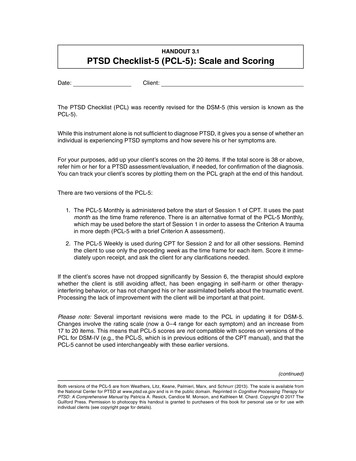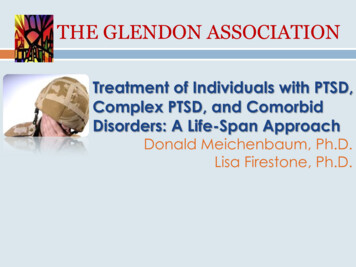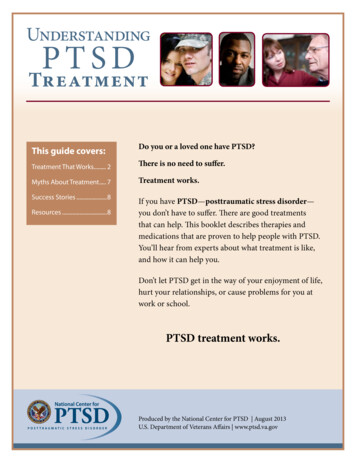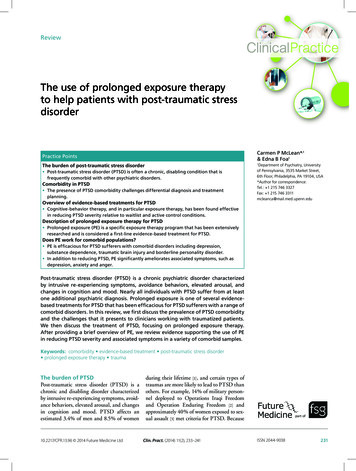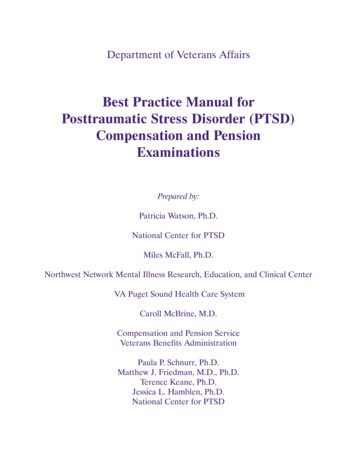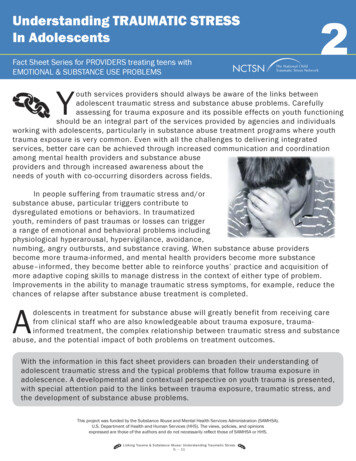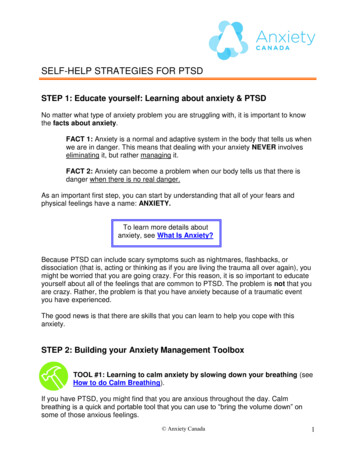
Transcription
SELF-HELP STRATEGIES FOR PTSDSTEP 1: Educate yourself: Learning about anxiety & PTSDNo matter what type of anxiety problem you are struggling with, it is important to knowthe facts about anxiety.FACT 1: Anxiety is a normal and adaptive system in the body that tells us whenwe are in danger. This means that dealing with your anxiety NEVER involveseliminating it, but rather managing it.FACT 2: Anxiety can become a problem when our body tells us that there isdanger when there is no real danger.As an important first step, you can start by understanding that all of your fears andphysical feelings have a name: ANXIETY.To learn more details aboutanxiety, see What Is Anxiety?Because PTSD can include scary symptoms such as nightmares, flashbacks, ordissociation (that is, acting or thinking as if you are living the trauma all over again), youmight be worried that you are going crazy. For this reason, it is so important to educateyourself about all of the feelings that are common to PTSD. The problem is not that youare crazy. Rather, the problem is that you have anxiety because of a traumatic eventyou have experienced.The good news is that there are skills that you can learn to help you cope with thisanxiety.STEP 2: Building your Anxiety Management ToolboxTOOL #1: Learning to calm anxiety by slowing down your breathing (seeHow to do Calm Breathing).If you have PTSD, you might find that you are anxious throughout the day. Calmbreathing is a quick and portable tool that you can use to “bring the volume down” onsome of those anxious feelings. Anxiety Canada1
NOTE: If you experience flashbacks or dissociation, it is a good idea tokeep your eyes open when doing calm breathing.TOOL #2: Learning how to calm your anxiety by relaxing the muscles inyour body (see How to do Progressive Muscle Relaxation).Because many people with PTSD are tense and jumpy throughout the day, it can bevery helpful to learn how to relax your body.Calm breathing and progressive musclerelaxation can you help to reduce some of theanxious and tense feelings in your body.TOOL #3: Grounding techniquesGrounding is a very helpful technique if you are experiencing flashbacks andyou find yourself sometimes losing touch with the present moment. Having this symptomof PTSD is not only terrifying for you, but it can also be scary for people around you,such as friends and family.Grounding teaches you to stop losing touch with the present moment by concentratingand focusing on the present or by directing your attention to something else.Some Examples of GroundingTouch objects around you, and describe them (texture, colour). For example, “I’msitting on a red chair, and the fabric is really soft; it’s velvet. The carpet is beige,and there is a red couch in the corner.”Run water over your hands, and describe aloud how it feels.Name all the different types of animals you can think of (e.g., zebra, cat, dog,cow, etc ), or types of flowers, cities in B.C., etc Say the alphabet backwards Anxiety Canada2
TIPS FOR GROUNDING:1. Eyes open. When doing grounding techniques, make sure to keepyour eyes open, so that you can see and focus on what is around youright now. It is also a good idea to speak out loud, describing what youare seeing and doing.2. Practise: Like any other skill, it is important to practise groundingtechniques. It will be most useful if you have tried using this skill whenyou were calm, and you practised it often. That way, when you findyourself needing to use it, you already know how.3. Enlist help: Teach a friend or family member about grounding andwhy you need to use it. If someone you trust understands whengrounding is useful, they can remind you to use it (and do it with you) ifyou are starting to lose touch with the present. For example, they mightsay, “I think you might want to do some grounding now can youdescribe what you are wearing? What am I wearing? Where are weright now?”TOOL #4: Getting back into your lifeSometimes adults with PTSD will stop doing the things that they used toenjoy, and isolate themselves by avoiding friends and family. Although this is anunderstandable reaction after living through a trauma, it is not helpful.Even though it might be difficult, it is important to get back into the normal routine of yourlife as soon as possible; this includes going to work, socializing with friends, and keepingup with hobbies or sports that you enjoy.KEY: If it feels too difficult to get back to your usual activities, such asgoing to work, start with short pleasant activities that will take you out ofthe house for a brief period of time. These might include: going for coffeewith a friend, going to see a movie or renting a DVD, or going out for awalk. Even a small step toward getting back into your life is a positivestep forward!It is also important that you take proper care of yourself. Some people with PTSD stoppaying attention to what they eat, when they sleep, or whether they are getting enough Anxiety Canada3
exercise. Unfortunately, these bad habits can actually make your anxiety worse. For tipson how to practise good habits and take care of yourself, see Tips for Healthy Living.TOOL #5: Facing your fearsSome adults with PTSD will find themselves avoiding situations that areassociated with the trauma they experienced. Some examples of this avoidance include:o If you were in a car accident, you might be avoiding driving, being in cars,walking in areas where there is a lot of traffic, or being in theneighbourhood where the accident took place.o Avoiding general places, situations or people associated with your trauma,such as parks, crowded places, and people of a particular ethnicity, age, orgender.o Avoiding trauma reminders such as movies, TV, conversations.The best way you can help yourself to deal with these fears is by facing them, ratherthan avoiding them. Normal activities such as driving or being in a car or reading thenewspaper are best addressed by gradually approaching these situations. For tips onhow to do reduce your avoidance see Facing Your Fears –Exposure.STEP 3: Knowing when to ask for help Although the skills listed here can be very effective in helping you to manage youranxiety, sometimes they are not enough. For example, you might feel completely unableto be around others or to face some of your fears by yourself. This is understandable,since dealing with PTSD can feel like an overwhelming struggle.If this is the case for you, it might be a good idea to consult with yourfamily doctor, a psychiatrist or a psychologist/mental health worker to getsome help in dealing with your PTSD. Working with someone trained indealing with PTSD can also give you a chance to talk about any feelings ofguilt, shame, or self-blame you might have because of your traumatic experience.Why do I need to deal with my guilt?Many people with PTSD think that they are either responsible for what happened insome way, that they could have prevented it, or that others would blame them if theyknew “the whole story”. For example, it is not uncommon for people who have beensexually assaulted to think that they didn’t “fight back” enough, or that they acted in acareless way that invited or encouraged the attack. Anxiety Canada4
Thoughts of guilt about a traumatic event can lead to strong negative feelings ofsadness, depression, and shame.KEEP IN MIND:Although it is common for people with PTSD to feel very guilty aboutwhat happened to them or the way that they acted during the trauma,these thoughts and feelings are false. No one can predict the future,so you could not have predicted the trauma occurring. Also, it is easyto think about what you should have done, after it has alreadyhappened: knowing what you could have done (if you had predictedthe trauma before it happened) does not mean that you are wrong or toblame for what you did do (see Realistic Thinking for moreinformation).A therapist can help you to talk through these thoughts and feelings,which is an important step toward coping with your PTSD.STEP 4: Building on braveryRemember that any progress you make in managing your anxiety and PTSD symptomscomes from a lot of hard work. If you are noticing improvements, take the time to giveyourself some credit: reward yourself!The best way to see your progress is to record all the work you are doing with yourPSTD management skills. For example, write down how often you use relaxation orgrounding techniques, and how effective it was each time. If you are trying to get outand socialize more, keep a record of the activities you have participated in each week.Set realistic goals for yourself, and reward yourself when you achieve those goals.How do you maintain all the progress you made?PRACTISE, PRACTISE, PRACTISE!!The PTSD management skills presented here are designed to teach you new and moreeffective ways of dealing with your anxiety. If you practise them often, they can becomenew habits that are a part of your daily routine.Like an exercise program, it is important to “keep in shape” even when you are feelingbetter and you have reached your goals.For more information on how to maintain your progress and how to cope with relapses insymptoms, see Learning about Relapse Prevention. Anxiety Canada5
Sometimes adults with PTSD will stop doing the things that they used to enjoy, and isolate themselves by avoiding friends and family. Although this is an understandable reaction after living through a trauma, it is not helpful. Even though it might be difficult, it is important to get back into the normal routine of your
